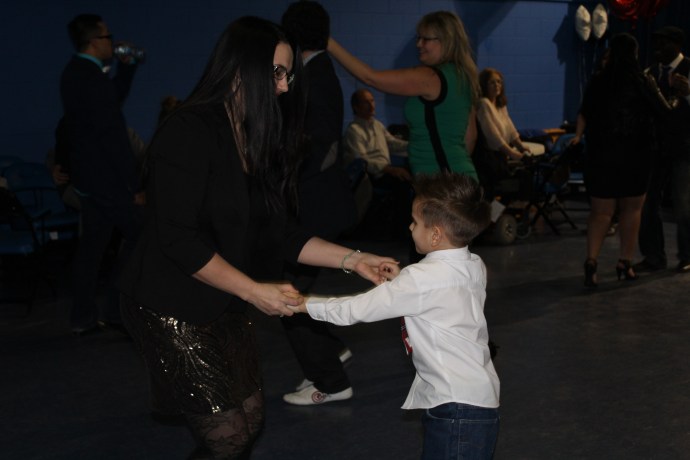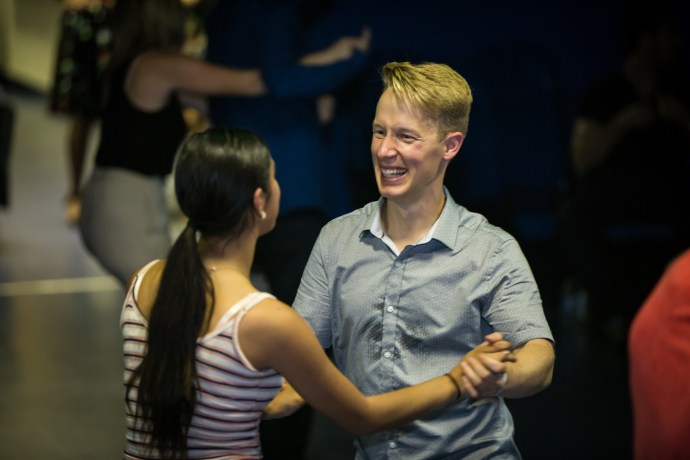We have all seen incredible performances by children with awesome dance talent. Some of the youth performances I’ve seen at congresses have blown my mind and even more impressive are the kids who can lead and follow with ease on the dance floor. That being said, some dances (bachata and kizomba, for example) can be very sensual and many people feel as though it’s inappropriate for children to dance in such a manner (with other children and especially with adults). Where do we draw the line between encouraging youth to be involved in a positive activity and protecting kids from being sexualized and growing up too fast? I’m sure there is not a simple answer, but as an educator, I have given this some thought. Here are some helpful suggestions to encourage kids (and keep them safe) in a partner dancing environment. These are ideas for parents, dance teachers, and community members to consider when young people express interest in social dancing.
1. Encourage kids to take partner dancing classes.
By taking classes, children and teens will learn skills more effectively and will be better equipped to lead and/or follow with ease. This can help alleviate some of the awkwardness associated with being a beginner dancer. In addition, they will meet other dancers in a comfortable setting where everyone is learning together. They will also learn about social dance and performance opportunities in the community. Most importantly, they will learn what is appropriate or normal partner dance behaviour. By learning dance etiquette, they will know what to expect when social dancing and be able to recognize if someone is not being respectful.
2. Introduce kids to people in your social dance community.
If you notice kids dancing at an event, introduce yourself to them and/or their parents. Ask them to dance, then introduce them to other dancers you know and trust. If they get to have many positive social dancing opportunities, this will encourage them to keep learning. It will also show them and their parents how safe and welcoming the environment is. I remember dancing with an eleven-year-old boy at one of his first salsa nights; he had been too nervous to ask anyone to dance, so I asked him. I complimented him on his timing and leading skills–he led a pattern better than some of the adults! After that, he seemed more confident to approach other dancers.

3. Make sure adults are aware that they are dancing with kids.
Sometimes, pre-teens and adolescents appear to be older than they actually are which can be problematic for a number of reasons. There is no need to make a big production out of it, but it is important to mention to people, “hey that is a student from my youth class,” or “she is in the teen performing group.” The more adults are aware they are dancing with teens, the safer the teens will be. You may think it’s no big deal and therefore not worthy of concern, but I have brought some of my high school students to salsa events and I can say from experience that it is absolutely essential to mention their age. As wonderful and respectful as the social dance world can be, there are individuals who dance a little bit too close or flirt on the dance floor. Awareness is key.
4. Tell naysayers that DANCE is NOT about SEX.
I’ve mentioned the “dance isn’t sex” argument in other articles (click here for an example) because most films about social dance present it under a romantic lens. Dancing is dancing. It is a fun, safe, and healthy activity that brings people together. There will always be people who perceive partner dancing (Latin dancing in particular) to be overtly sexual and therefore inappropriate for children. Remind those who hold this view that that is not the case. Partner dancing is about building trust, confidence, and community. It teaches people to respect themselves and respect one another. Honestly, the Latin dance community is a safe environment for dancers of all levels and ages. While there may be some individuals who do not want to dance with kids or who don’t know how to dance appropriately (likely because they are inexperienced), the majority of salseros know how to show young people the ropes. So, look out for kids on the dance floor and be a positive influence. Let’s nurture the next generation of salseros!

5. Choreograph age-appropriate routines.
Although I just said dance is not about sex, it can be very sensual. This is difficult to address because art is subjective and so is the notion of “age-appropriate!” Instructors and coaches must be mindful of the age group of the dancers when putting together a routine. In particular, if children are dancing with adults, a choreographer should be careful to avoid sexualizing youth. I have seen some routines in which adult men are dancing with twelve, thirteen, or fourteen-year-old girls (and if nobody had told me their age, I would never have been able to guess). These routines were beautiful, but I felt uneasy watching such young women moving so provocatively with grown men. The safety of these girls should be the number one concern; although they may be smart enough and confident enough to make their own decisions and move how they want to, there could be audience members who get the wrong idea from their movements. A friend of mine is a salsa instructor and she describes how she wants to protect her daughter and keep her safe; so, her salsa class for little girls keeps the movements very innocent in comparison to the sexy moves from her adult ladies styling class. I hope all instructors make the same considerations. By expressing my concern, I’m not trying to say that dance should be censored (nor that it’s only the girls we need to worry about), but it’s worthwhile to have these conversations and make sure kids aren’t being exploited in any way.
To summarize, I’m all for nurturing the younger generation to hit the floor. It’s pretty cool to watch kids grow up in a dance environment and blossom into incredible dancers. As adults, it is our responsibility to look out for kids, to encourage, guide, and protect them. When it comes to partner dancing and choreography, some people believe that teaching kids to move in a way that is even remotely sensual is completely inappropriate and unfair to the kids; others argue it is authentic, empowering and beautiful art. What are your thoughts on this topic? Please share your comments below.

First and foremost, teach children what partnering is (not lead & follow) and that dancing is about feeling music and not choreographed routines. Get it right from the beginning on.
Hi Sarah. Thanks for the great post. Yes, we’ve had teenage students and some of the men didn’t know they were minors. They guys appreciated knowing so that they could be more careful to be appropriate in all manners. We’ll share your link with our social media channels. Thanks again.